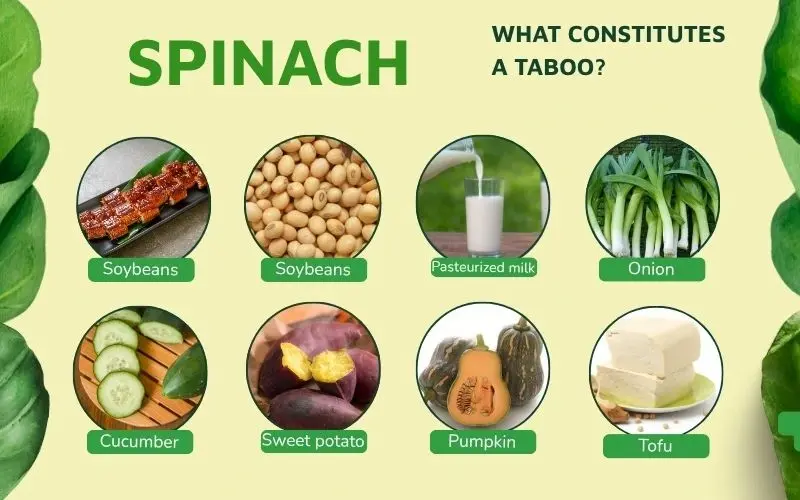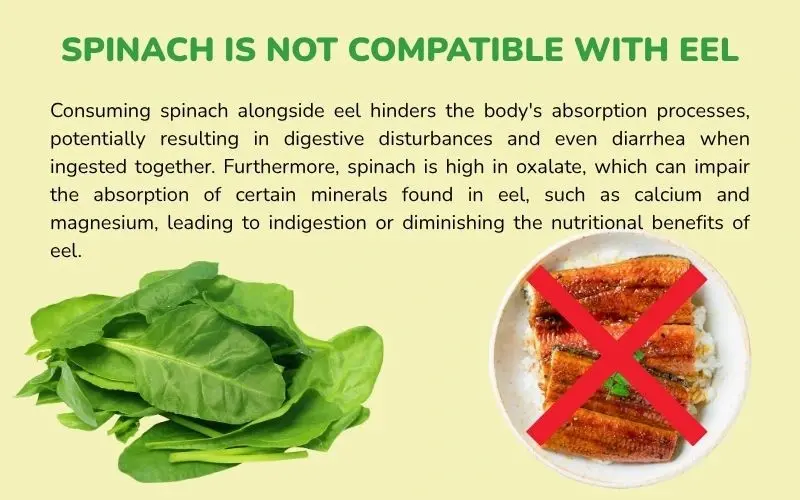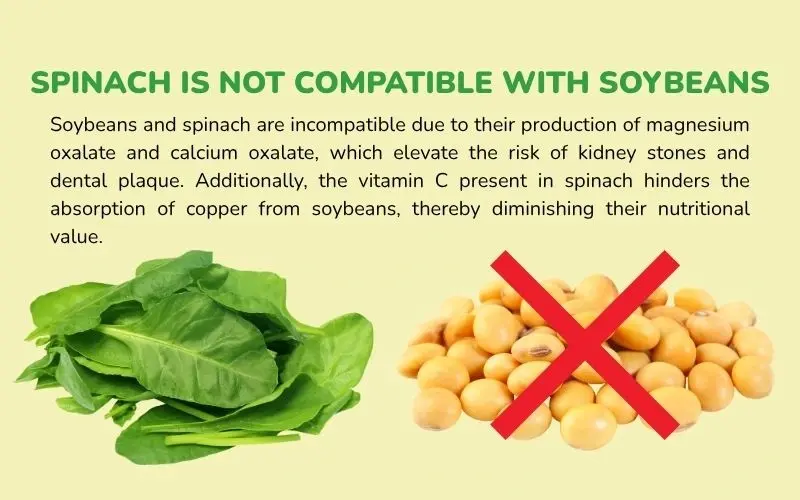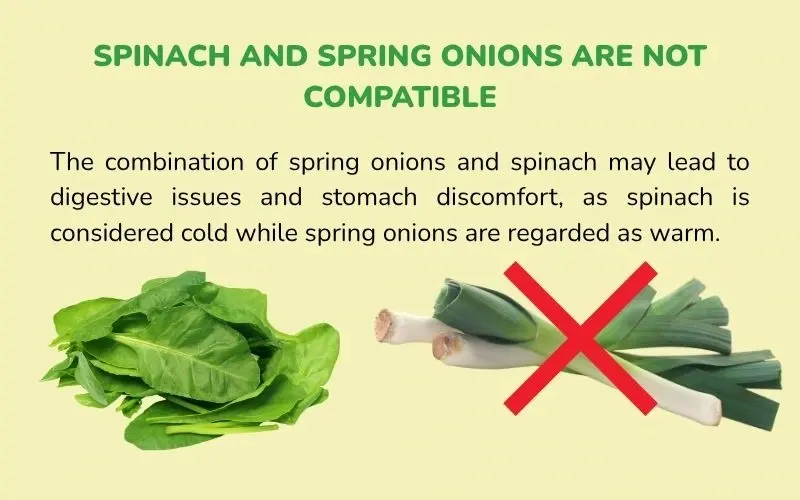What should spinach not be combined with is a question many people have when using this vegetable in their daily meals. Although very nutritious, spinach can have negative effects if combined incorrectly, especially with foods like eel, soybeans, milk, cucumbers, pumpkins, sweet potatoes, and leeks. To understand this better, let’s explore in detail the foods that should not be combined with spinach and who should be cautious when eating it in the article below!
What Should Spinach Not Be Combined With?
Although spinach is a very healthy vegetable, it is not safe to combine it with just any food. Below are some food groups you should be careful about when eating with this vegetable:

Spinach and Eel
Eel has a sweet, warming nature and is often used in traditional Eastern medicine to boost blood and energy. In contrast, spinach is cooling and helps to clear heat from the body. This opposing nature can make the body difficult to absorb, easily causing digestive upset, and even leading to diarrhea when eaten together. Additionally, spinach contains a lot of oxalates, which can affect the absorption of certain minerals in eel, such as calcium and magnesium, causing indigestion or reducing the nutritional effectiveness of the eel.

Spinach and Soybeans
Soybeans are rich in minerals like magnesium, calcium sulfate, and chloride, while spinach is rich in oxalic acid. When combined, these compounds can easily form magnesium oxalate and calcium oxalate—insoluble precipitates that increase the risk of forming kidney stones or dental calculus.
Furthermore, spinach also contains vitamin C, a nutrient that can inhibit the absorption of copper from soybeans. This makes it difficult for the body to fully receive essential micronutrients, affecting the nutritional effectiveness of both foods.

Spinach and Milk
The combination of oxalic acid in spinach and calcium in milk will create calcium oxalate. This is an insoluble precipitate that the body finds difficult to absorb, which in turn affects calcium absorption and can easily lead to digestive issues like bloating and constipation.
Besides milk, you should also be careful when combining spinach with other calcium-rich foods like tofu, cheese, or eggs. Similar to milk, this combination can also create undesirable conditions that negatively affect your health.

Spinach and Leeks
Leeks are often used with spinach to create a delicious dish. However, this combination can cause digestive upset and an uncomfortable feeling in the stomach if eaten frequently. The reason is that spinach has a cooling nature, while leeks are pungent and warming. This opposition increases the likelihood of causing abdominal pain, diarrhea, and negatively affecting the digestive system.

Spinach and Cucumbers
Cucumbers contain a catabolic enzyme that can break down vitamin C. Meanwhile, spinach is a rich source of vitamin C. If you eat these two foods at the same time, the enzyme in the cucumber will destroy the valuable vitamin C in the spinach, significantly reducing the nutritional value of the dish.

Spinach and Beans/Sweet Potatoes
Spinach, beans, and sweet potatoes all contain a substance called phytic acid. When you eat these foods together, phytic acid combines with calcium in the body to form salts. This not only reduces the body’s ability to absorb calcium but also accelerates the elimination of this mineral, negatively affecting bones and joints.

Spinach and Pumpkin
Similar to cucumbers, pumpkin also contains an enzyme that can break down vitamin C. If eaten with spinach, the valuable vitamin C in this vegetable will be significantly reduced, which affects the overall nutritional value of the dish.

Who Should Not Eat Spinach?
Not only do you need to avoid combining spinach with certain foods, but some groups of people should also limit or avoid eating spinach to protect their health, such as:
People with Allergies
People with a history of allergies to latex or beets are at risk of a similar reaction to spinach. To be safe, you should try a small amount before adding it to your regular diet, to avoid unwanted reactions like rashes, itching, or difficulty breathing.

People with Calcium or Iron Deficiency
Because it contains oxalates, spinach can inhibit the absorption of calcium and iron in the body. For people who are deficient in these two minerals, eating a lot of spinach can worsen the deficiency. Therefore, if you are low on calcium or iron, it is best to prioritize alternative foods like beans, nuts, fish, and red meat.
People with Gout
Spinach contains purines, a substance that can increase the concentration of uric acid in the blood. High levels of uric acid can cause crystal deposits in the joints, leading to gout. Therefore, people with gout should limit their intake of spinach to avoid making the condition more severe.

People with Kidney Stone Problems
The high amount of oxalates in spinach can easily combine with calcium in the body to form calcium oxalate crystals—one of the leading causes of kidney stones. Therefore, people with a history of kidney disease or who are being treated for stones should avoid consuming spinach regularly.
People with Thyroid Disorders
Spinach contains goitrogens—substances that can interfere with thyroid function by blocking the absorption of iodine. If you have a thyroid problem, you should consult a doctor before including this vegetable in your diet.

People Preparing for Surgery
Because spinach contains a high amount of vitamin K1—a substance that promotes blood clotting—it can affect the effectiveness of blood thinners used before and during surgery. To ensure safety, you should stop eating spinach a few days before the operation.
People with Histamine Intolerance
Spinach contains a high amount of natural histamine, which is a compound that can cause allergic symptoms. Histamine intolerance occurs when the body cannot process high levels of histamine found in some foods, leading to symptoms such as itching, hives, stuffy nose, sneezing, abdominal pain, vomiting, and diarrhea. A food allergy occurs when the immune system overreacts to food, producing too much histamine.
Allergic symptoms to spinach can include: itching, hives, stuffy nose, sneezing, itchy eyes, vomiting, abdominal pain, diarrhea, and swelling. In severe cases, an allergy can cause anaphylaxis, which includes symptoms such as a hoarse voice, shortness of breath, and a feeling of impending doom. Anaphylaxis is a medical emergency, and you need to call an ambulance immediately if you experience severe symptoms.
Diagnosing a spinach allergy may involve tests such as skin prick tests, blood tests, oral challenges, and elimination diets. If you suspect you have an allergy, you should consult a doctor for an accurate diagnosis and treatment.
The treatment for spinach allergy is mainly to avoid eating spinach and foods containing it. Antihistamines can be used to reduce allergic symptoms. Additionally, if you are at risk for anaphylaxis, your doctor may prescribe an epinephrine auto-injector (EpiPen) for use in an emergency.
Precautions When Eating Spinach
To eat spinach safely and scientifically, you should follow a few important precautions below.
- Cook spinach thoroughly: Raw spinach contains a lot of oxalates, which can hinder the absorption of calcium and iron, especially for people with kidney problems. When cooked, the amount of oxalates will be significantly reduced, making it easier for the body to absorb other nutrients.
- Do not eat too much spinach every day: Although spinach is very nutritious, eating too much can cause digestive problems such as bloating, diarrhea, and constipation, as spinach contains a lot of insoluble fiber. You should only eat spinach in moderation, about 100-200 grams per week, to avoid an excess of fiber and oxalates.
- Avoid combining with incompatible foods: Do not eat spinach with eel, soybeans, pumpkin, beans, milk, leeks, cucumbers, sweet potatoes, and purine-rich seafood.
- Combine spinach with vitamin C-rich foods: Spinach is a source of non-heme iron (the type of iron found in plants), but the body finds it difficult to absorb this type of iron without the support of vitamin C. Combine spinach with vitamin C-rich foods such as oranges, grapefruit, or red peppers to enhance iron absorption.
- Avoid eating spinach while on blood thinners: Spinach is rich in vitamin K1, which can affect the effectiveness of blood thinners like warfarin. Vitamin K1 helps promote blood clotting, so people taking blood thinners need to be careful when eating spinach. If you are on blood thinners, consult your doctor before eating spinach to adjust your vitamin K1 intake.
- Wash and cook thoroughly: You should wash spinach very well to remove impurities and cook it thoroughly to reduce the amount of oxalates, which helps to limit the risk of harm to the kidneys and digestive system.
- Consult a professional if you have medical conditions: Especially for people with kidney stones, gout, thyroid disorders, or those preparing for surgery.
- Store properly: Fresh spinach should be stored in the refrigerator and used within 1-2 days to ensure it retains its nutritional value.

Can You Eat Raw Spinach?
Nutrition experts warn against eating raw spinach because it can be harmful to your health. The main reason is oxalates, a compound in spinach that is difficult to absorb and can combine with calcium in the body, forming crystals that cause kidney stones and gallstones. Consuming too much raw spinach can lead to digestive problems such as bloating, constipation, diarrhea, and irritable bowel syndrome. Raw spinach also hinders the absorption of minerals like calcium and iron.
To avoid these risks, experts recommend cooking or blanching spinach before eating. Cooking spinach significantly reduces the amount of oxalates and retains many nutrients such as iron, beta-carotene, and lutein. If you eat raw spinach, you should reduce the amount consumed and consider cooking methods such as stir-frying, making soup, or side dishes.
Nutritional Content and Benefits of Spinach
Nutritional information for 100g of raw spinach:
- Energy: 23 kcal
- Water: 91%
- Protein: 2.9 grams
- Carbohydrates: 3.6 grams
- Sugar: 0.4 grams
- Fiber: 2.2 grams
- Fat: 0.4 grams
Spinach, also known as bina or chân vịt (duck feet) vegetable, is a dark green leafy vegetable native to Southwest Asia, belonging to the amaranth family. It has large leaves with small, soft stems and is easy to cook. From stir-fries and boiled dishes to soups and juices, spinach always has a mild, sweet taste that is easy to eat and suitable for all ages, from children to the elderly.
The nutritional content of spinach is very rich, including vitamins A, C, E, calcium, iron, fiber, and many antioxidants. Thanks to its rich nutrient profile, spinach helps support beautiful skin, prevents aging, stabilizes blood sugar, and reduces the risk of diabetes. Including spinach in your daily menu will help improve the health of the entire family.

Conclusion
Hopefully, through this article, you now know what spinach should not be combined with and who should be cautious when eating this vegetable. Combine spinach scientifically to protect your health and make the most of its valuable nutrients. Don’t forget to visit kamereo.vn to shop for fresh, high-quality vegetables and fruits!
See more:
References:



